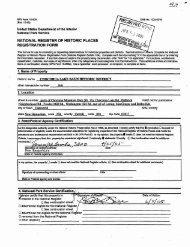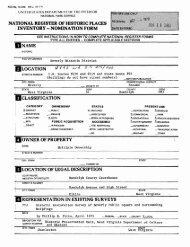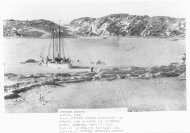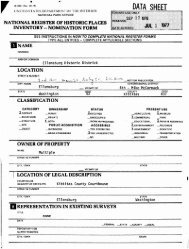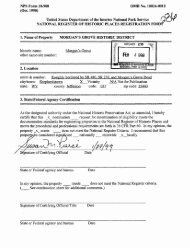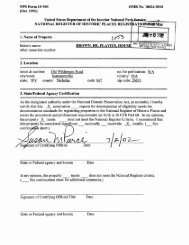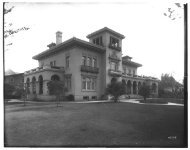National Register of Historic Places Registration Form
National Register of Historic Places Registration Form
National Register of Historic Places Registration Form
Create successful ePaper yourself
Turn your PDF publications into a flip-book with our unique Google optimized e-Paper software.
NPS <strong>Form</strong> 10-900-a 0MB Approval No. 1024-0018<br />
(846)<br />
United States Department <strong>of</strong> the Interior<br />
<strong>National</strong> Park Service<br />
<strong>National</strong> <strong>Register</strong> <strong>of</strong> <strong>Historic</strong> <strong>Places</strong><br />
Continuation Sheet<br />
CLEVELAND PARK HISTORIC DISTRICT<br />
WASHINGTON D.C.<br />
Section number 8 page _Z__<br />
CRITERIA CONSIDERATIONS:<br />
There are no intruding buildings within the boundaries <strong>of</strong> the Cleveland<br />
Park <strong>Historic</strong> District. Significant compatible structures, which are an<br />
integral part <strong>of</strong> the district, have continued to be designed and built up to<br />
the present. However, according the <strong>National</strong> <strong>Register</strong>'s criteria all <strong>of</strong> the<br />
post 1941 additions to the district have been deemed to be noncontributing<br />
structures because <strong>of</strong> their age.<br />
The Cleveland Park <strong>Historic</strong> District embodies a community that has<br />
developed over time. From 1880 to 1941 the majority <strong>of</strong> the architectural<br />
fabric was constructed. Since 1941 some residences have been constructed on<br />
vacant lots within the boundaries <strong>of</strong> the historic district. In 1952 the Post<br />
Office was constructed on a vacant lot on Connecticut Avenue and in subsequent<br />
decades a few <strong>of</strong> the commercial buildings have renewed their facades. These<br />
architectural structures are an integral part <strong>of</strong> the historic district and are<br />
compatible in scale, location, design, setting, materials, workmanship,<br />
feeling and association. Several residences constructed since 1941 are<br />
outstanding examples <strong>of</strong> the work <strong>of</strong> nationally significant architects. I.M.<br />
Pei designed a house on Ordway Street in 1962, one <strong>of</strong> only two houses designed<br />
by him throughout his long career. Winthrop Faulkner, a Washington D.C.<br />
architect designed a series <strong>of</strong> homes on Ordway and 35th streets in 1963, 1968<br />
and 1978 for his family illustrating his architectural style. Cleveland Park<br />
also has numerous quality renovations designed by locally and nationally known<br />
architects; several projects have been awarded AIA preservation awards. The<br />
quality that John Sherman sought to establish in his early architectural<br />
designs for Cleveland Park has been sustained throughout the years and<br />
continues to be pursued today as is evidenced by the most recently built<br />
residence on 35th street designed by architect Theresa Weinheimer and<br />
constructed in 1986.<br />
HISTORIC CONTEXT<br />
Cleveland Park, the streetcar suburb, is unique in Washington D.C.<br />
because <strong>of</strong> the concentration <strong>of</strong>-architect-designed late Victorian frame houses<br />
reminiscent <strong>of</strong> New England summer homes along the coast. It was the first<br />
electric streetcar suburb in Washington D.C. which was sufficiently successful<br />
that houses were constructed continuously from 1894 to 1901 representing<br />
diverse architects and a variety <strong>of</strong> contemporary popular styles. It is also<br />
unusual in that the suburban development beginning in 1894 was superimposed<br />
upon the land previously occupied by country estates (intact examples <strong>of</strong> which<br />
remain) rather than prior suburban dwellings as was the case with Mount<br />
Pleasant. Also unusual is that Cleveland Park maintained its rural ambiance<br />
throughout the period <strong>of</strong> its development to the 1940's. Unlike Mt. Pleasant,<br />
urban housing types were not introduced in great numbers thereby changing the<br />
suburban atmosphere. All <strong>of</strong> the streets between the avenues in Cleveland Park<br />
retain the suburban flavor <strong>of</strong> the initial development with a preponderance <strong>of</strong>



